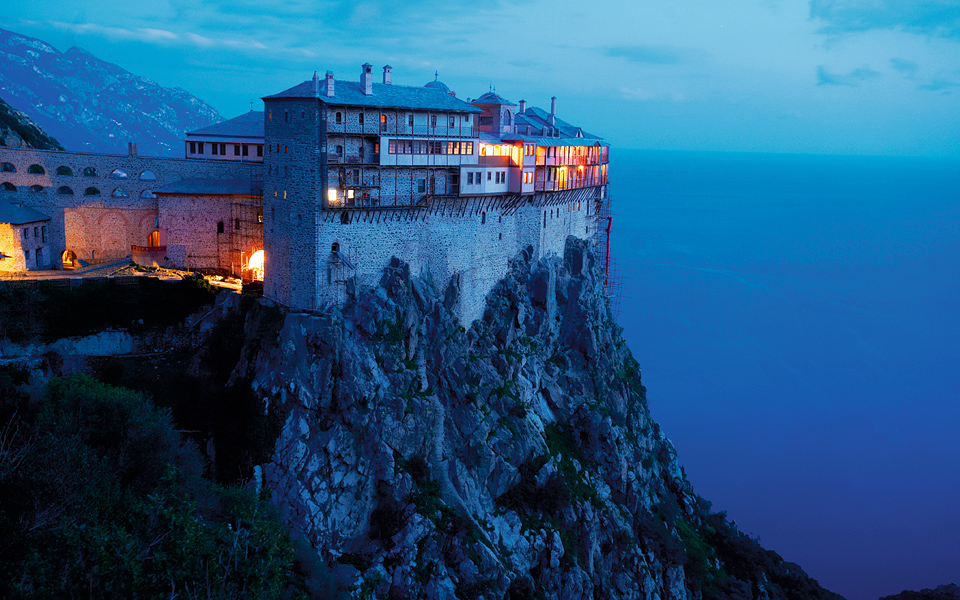On account of its profoundly mystical character, its prohibition on entry for women and its enormous religious symbolism and content, especially for Orthodox Christians, the Athos peninsula prompts you to approach Halkidiki in an entirely different way. This is, after all, the Ark of Orthodoxy, a refuge for men seeking a blessed place where they can draw closer to God through prayer and repentance. It is also a haven for those who feel the need to receive spiritual counsel, a fatherly caress, so that they may come closer – albeit briefly – to the divine.
The journey there takes you first to Ouranoupoli – the harbor and last settlement before the monastic state. The touristic aspect fades, gradually replaced by the devotional element. As the boat approaches the jetty in the small harbor, an imposing 14th century tower, which once called to Prosforion, an exdependency of the Vatopedi monastery, comes into view. Most of the men on the boat hold only a small piece of luggage as they prepare to disembark. One of the first things you notice getting off the boat is the very large number of places to stay; these are used to accommodate the pilgrims.
The easternmost “leg” of the Halkidiki peninsula holds a very special place in the tradition of the Orthodox Church, one that sets it apart from the other two similarly shaped “legs” and the surrounding region, perhaps even from the entire world. According to this tradition, the Blessed Virgin, immediately after the resurrection of Jesus, left the Holy Land with St John the Evangelist and, after a stormy sea voyage, reached the shores of Akti, as the Athos peninsula was then known. Mary was so enchanted by the beauty and the tranquility of the landscape, that she asked her Son to give it to her as a gift. Ever since, the Athos peninsula became known as the “Garden of the Mother of God” and has been dedicated to her grace.
“The easternmost “leg” of the Halkidiki peninsula holds a very special place in the tradition of the Orthodox Church.”
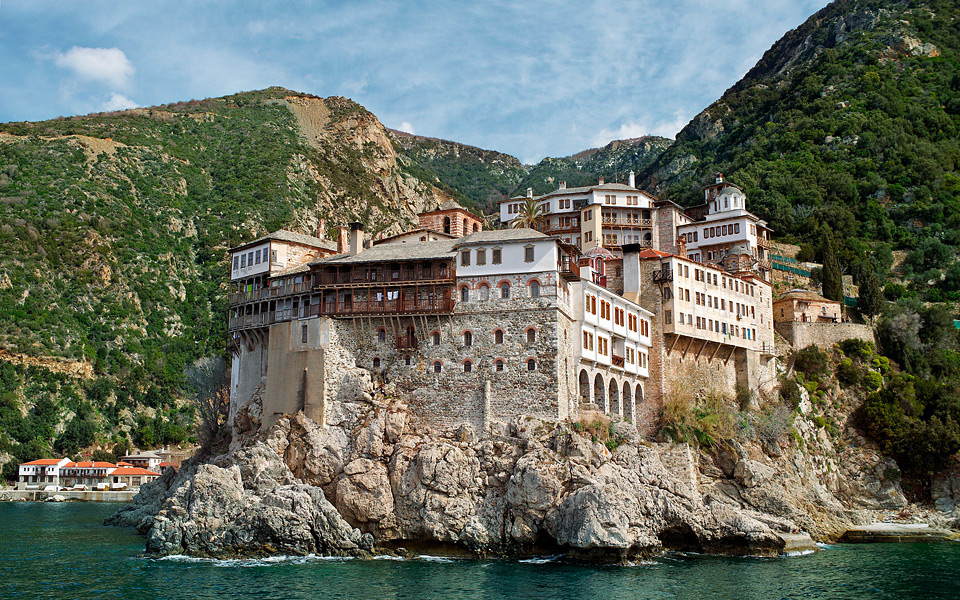
© Shutterstock, Ephorate Of Antiquities Of Chalkidiki And Mount Athos/Hellenic Republic, Ministry Of Culture And Sports/Archaeological Receipts Fund
AVATON
According to the written rules of Mt Athos, it is forbidden for women to enter by any means or stay anywhere in the monastic state. This prohibition is called avaton in Greek. Any breach of the rule is a punishable offence, because Mt Athos is dedicated to one woman whom all the monks honor and pray to; the Blessed Virgin
Approximately 50k long and a 10k wide, the Athos peninsula resembles the lush green natural setting of the rest of Halkidiki, at least in its northern half. The lower part is a more rocky, less verdant landscape dominated by the peak of Mt Athos (2,033m). Pilgrims visiting this extraordinarily beautiful land should not expect to see towns, villages or beaches with tourist facilities, hotels and restaurants. For more than 10 centuries, Mt Athos has been a unique religious state, the peaceful custodian of Orthodoxy, a place of sanctuary for men who have abandoned all things worldly and come here to become monks, in organized communities or hermitages.
Scattered across the peninsula there are 20 monasteries – 17 Greek, one Russian, one Serbian and one Bulgarian – along with their dependencies, namely 12 sketes and about 400 cells – plus an administrative center. In total, around 2,000 Orthodox monks live on Mt. Athos, most of them from Greece but many from other countries as well. The 20 monasteries are independent, self-governing and sovereign, though together they form the Holy Community of Mount Athos, under the spiritual jurisdiction of the Ecumenical Patriarchate of Constantinople.
A multilingual booklet on sale in Ouranoupoli will help you do some research and connect past and present during the sea crossing to the monastic state. Throughout its history, Mt Athos has always been a center of asceticism and retreat. In the Classical era, there were at least six temples dedicated to the ancient Greek religion of the Twelve Olympians (Dodekatheon), while in Early Christian times it was home to a number of ascetics and hermits, culminating in the 53-year stay of Saint Peter the Athonite in the 8th century. There were two main factors that impelled many monks to seek refuge on Mt Athos: the emergence and violent spread of Islam after the 7th century, and the Iconomachy, the conflict over the status of icons and other images as objects of worship, which lasted around 150 years, during which Mt Athos remained firmly on the side of the iconodules (those who favored icons).
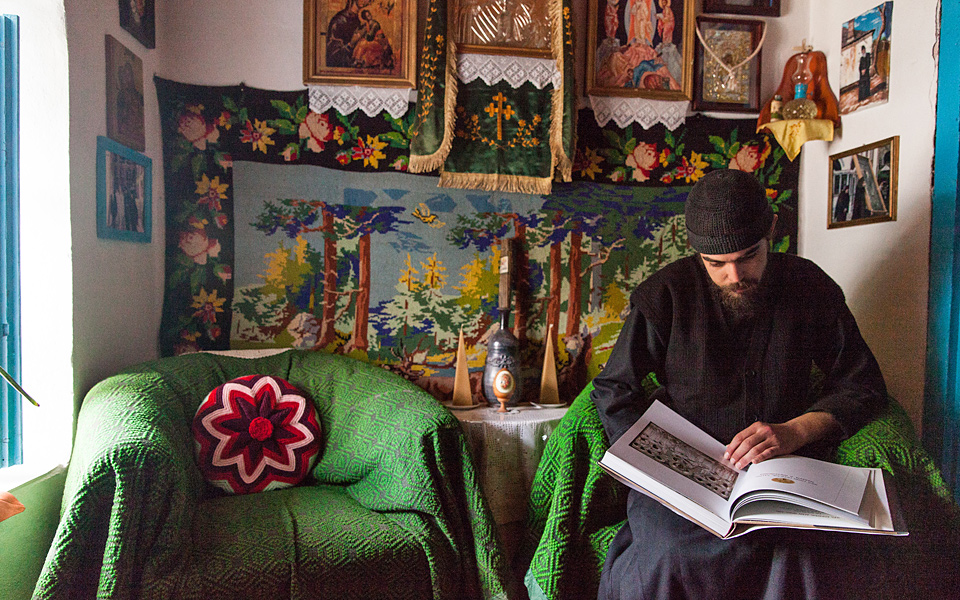
© Dimitris Vlaikos
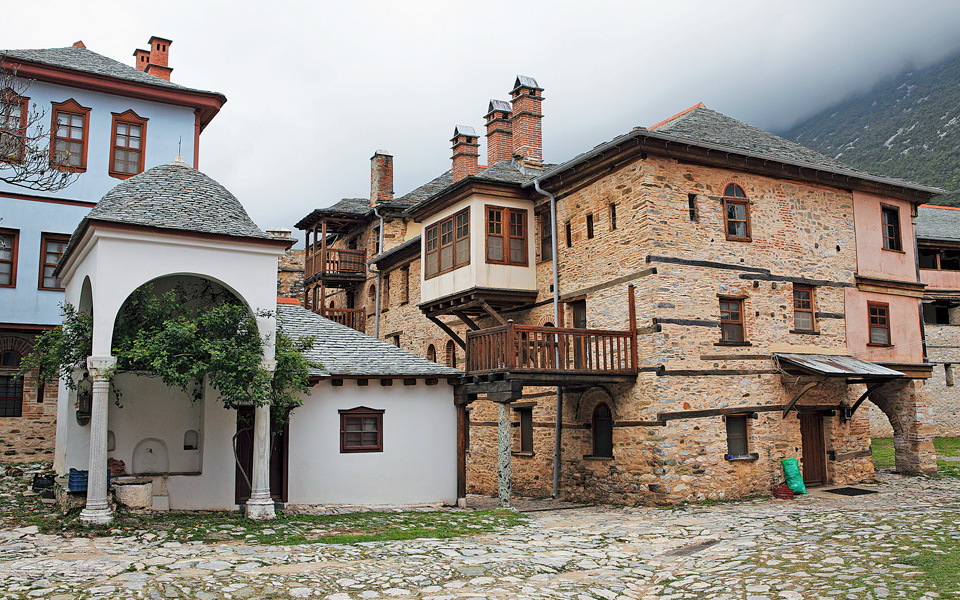
© Getty Images
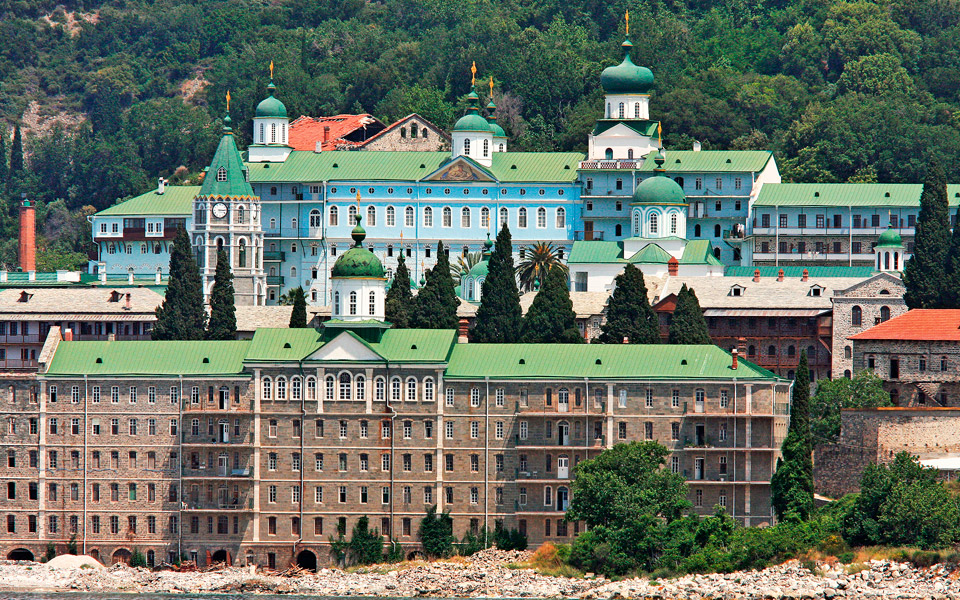
© Shutterstock
A milestone date in the history of Mt Athos is AD 963, which marks the official establishment of the monastic state. This is the year when Athanasios the Athonite founded the first organized monastery, Megiste (Great) Lavra, and instituted the rules governing not only its running but also the general conduct and day-to-day life of the monks. In the years that followed, more monasteries were founded, including Vatopedi, Iviron and Xenophontos, which still exist, as well as others that were abandoned over the centuries, such as Zygos and Morphonou (established by monks from the Italian maritime republic of Amalfi). As the monasteries and their dependencies sprung up one after the other in this part of the peninsula, they became home to hundreds of monks. From the 11th century onwards, due to increasing attacks by pirates, the scattered monastery buildings were converted into monastic fortresses, protected by high fortified walls and towers. Similar defenses were also constructed at the monasteries’ landing points, which were vital since all transportation of passengers and goods was by sea.
On Mt Athos, the imagination is fueled by unfamiliar sights and sounds, but curiosity and questions are soon displaced by the dignified and wisdom-filled silence of the monks, a quiet which further enhances the mystical nature of their presence there. Nevertheless, visitors have the opportunity to ascertain that the life of an Athonite monk is still guided by the rules laid down by the Venerable Athanasios, the particular rules of each monastery, and a monk’s obligation to observe his three vows of obedience, poverty and chastity. The life of a monk revolves around two main kinds of activities: there is prayer, spiritual preparation and active participation in the religious services, liturgies and rites; and there is the performance of the daily work assigned to each monk, collectively known as diakonimata (tasks or duties).
A monk’s daily schedule does not change: rising just after midnight for private prayer; from 4 in the morning taking part in morning liturgies and immediately afterwards, around 8:30-9:00, having the first meal of the day, observing all rules of abstinence or fasting, with meat forbidden entirely. Then each monk sets about his daily duties or tasks. At around 13:00, he takes a rest and at 16:30 he is at vespers, which is followed by the second and final meal of the day. The compline service is next, and then he has some free time for reading, meeting with his spiritual teacher or quiet contemplation until he calls it a day.
“On Mt Athos, the imagination is fueled by unfamiliar sights and sounds, but curiosity and questions are soon displaced by the dignified and wisdom-filled silence of the monks.”
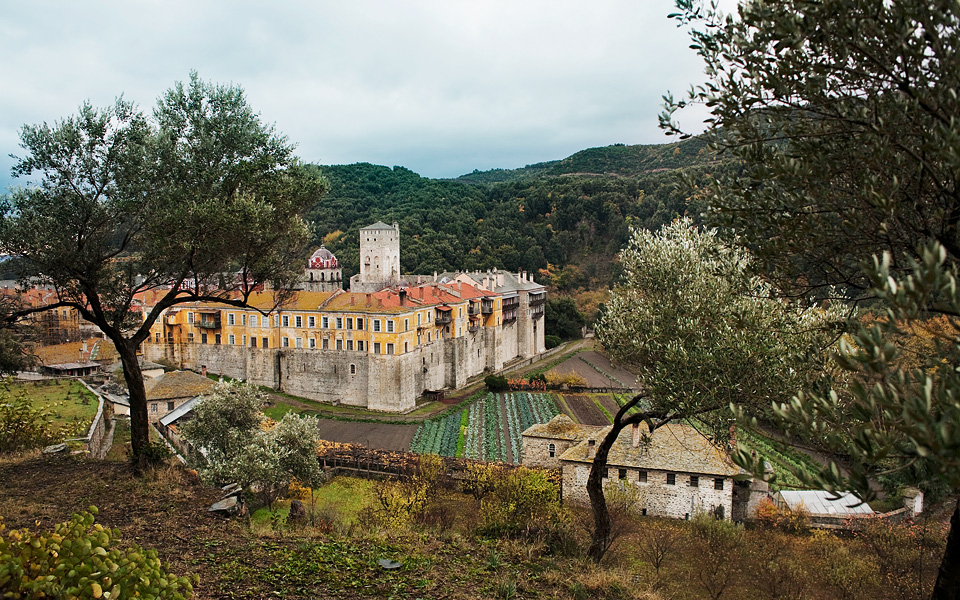
© Getty Images
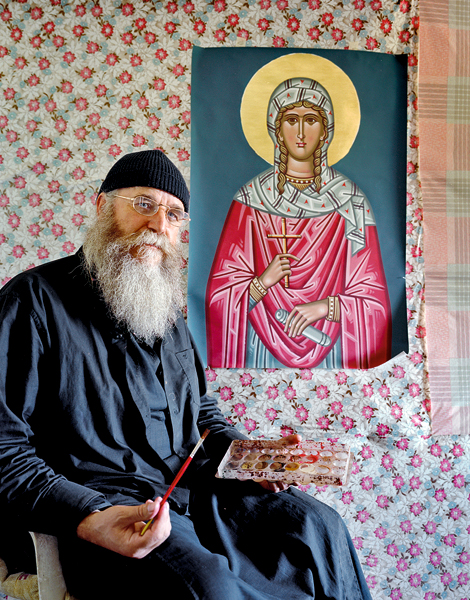
© Stratos Kalafatis
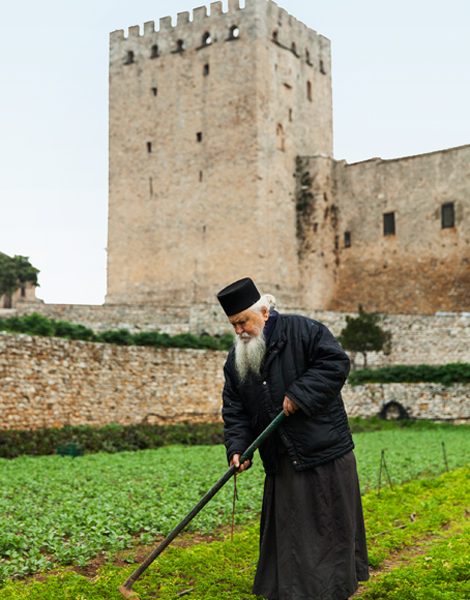
© Dimitris Vlaikos
“One of the most striking edifices here is the imposing Protaton, the oldest church on Mt Athos, adorned with wonderful 13th century frescoes by Manuel Panselinos.”
The highlight of any pilgrim’s acquaintance with daily life on Mt Athos is their participation in the religious services; Holy Mass and – for those seeking spiritual contact with a monk – confession. It should be stressed that not all visitors are the same. I have had the good fortune to accompany many visitors to Mt Athos. Some were believers, some less so, some were progressive and some were conservative, but they had one thing in common. They all indicated that the Holy Mountain had affected them in a singular way, whether to a greater or lesser degree, and never negatively.
MONASTERIES & ADMINISTRATION
The 20 monasteries in order of their place in the Athonite hierarchy are: Great Lavra, Vatopedi, Iviron, Helandariou, Dionysiou, Koutloumousiou, Pantokratoros, Xiropotamos, Zografou, Dochiareiou, Karakalou, Filotheou, Simonas Petras, Aghiou Pavlou, Stavronikita, Xenophontos, Osiou Grigoriou, Esphigmenou, Aghios Panteleimonas and Konstamonitou. Together, they form the Holy Community, whose seat is at Karyes, the only settlement on Mt Athos. Karyes is also the seat of the Greek Civil Authority and the base for all public services and utilities, including police, a health center, telephone exchange, post office, bank, fire department and a handful of small stores.
One of the most striking edifices here is the imposing Protaton, the oldest church on Mt Athos, adorned with wonderful 13th century frescoes by Manuel Panselinos, an exponent of the Macedonian School of painting, along with icons on the templon painted by Theophanes of the Cretan School in the 17th century. The church also houses the miraculous “Axion Esti” icon and is where the official services of the Holy Community are held.
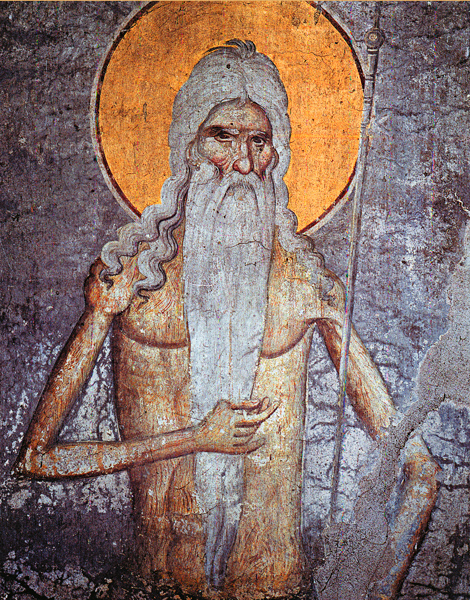
© Ephorate Of Antiquities of Chalkidiki and Mount Athos/Hellenic Republic, Ministry of Culture and Sports/Archaeological Receipts Fund
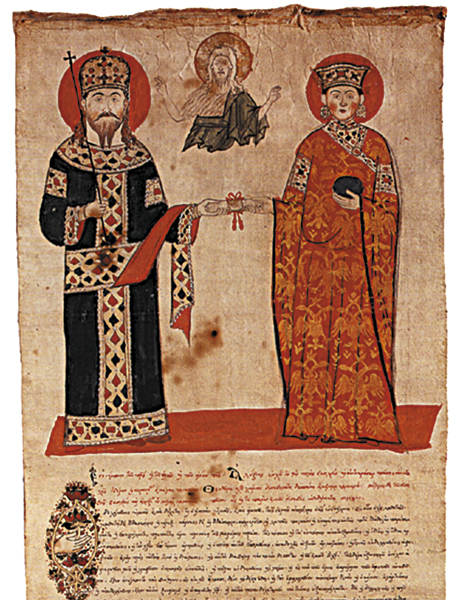
© Ephorate Of Antiquities of Chalkidiki and Mount Athos/Hellenic Republic, Ministry of Culture and Sports/Archaeological Receipts Fund
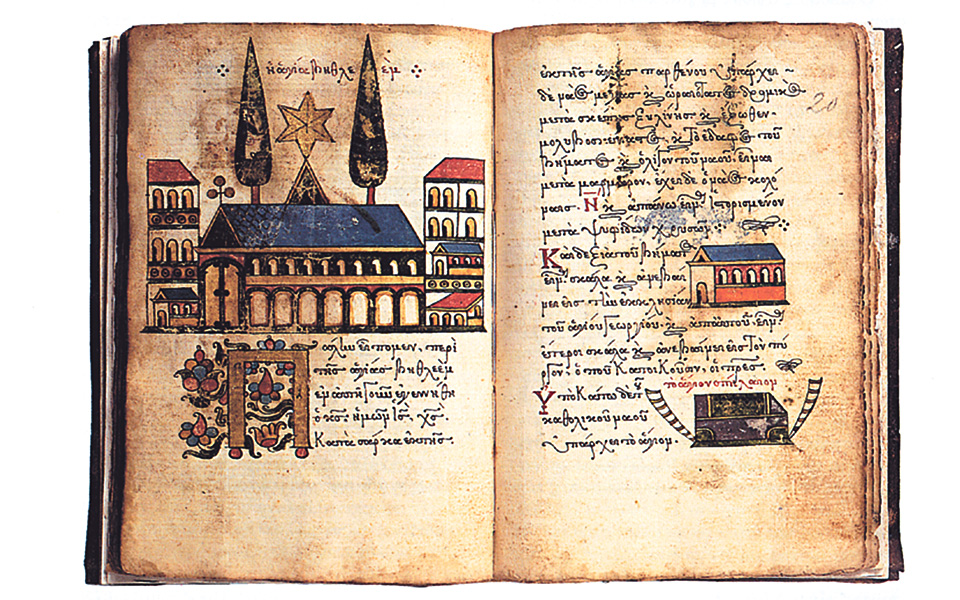
© Ephorate Of Antiquities of Chalkidiki and Mount Athos/Hellenic Republic, Ministry of Culture and Sports/Archaeological Receipts Fund
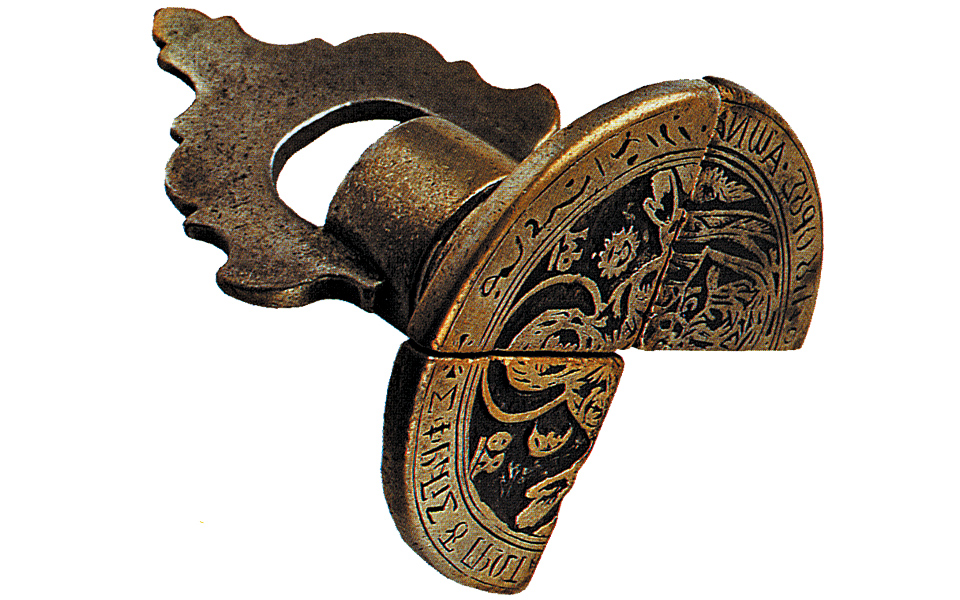
© Ephorate Of Antiquities of Chalkidiki and Mount Athos/Hellenic Republic, Ministry of Culture and Sports/Archaeological Receipts Fund
For centuries, Mt Athos has been administered in a truly democratic way, following the framework also of the official procedures laid down in its charter, ratified in 1924. Each monastery appoints one representative to the governing body, the Holy Community. These representatives, presided over by the Protos (lit. “First”), convenes every Monday and Thursday to discuss issues and make decisions. All the monasteries have been institutionally divided into five groups of four, from which five four-member Holy Councils (Iera Epistasies) are formed. Each Epistasia serves for one year, presided over by a representative from one of the five senior monasteries (on the basis of the hierarchy already mentioned). The rotating four-member Holy Epistasia assumes its administrative duties on 1 June each year, acting as a kind of executive authority of the Holy Community. The presiding representative of the senior monastery, the Protepistates, also holds the office of Protos for that year. During their term, the Protepistates and the three Epistates each hold one part of the great seal of the Holy Community, which is used to seal all documents. Naturally, the consent of all four council members is required in order to assemble the seal.
ENVIRONMENT & CULTURE
To the visitor, it is very clear that nature has generously endowed this place. Dense forests – particularly chestnut – olive groves and vineyards, but also sublime beaches, some 1,500 species of plants and an abundant fauna compose a unique natural environment, completely unspoiled. And while the buildings may be the most striking – monasteries, churches, towers and cells – there are also many extraordinary works of art, rich libraries with manuscripts and heirlooms, centers and schools for icon painting and carpentry, as well as classes in liturgical chant and in traditional methods of producing oil and wine. Mt Athos constitutes a very unique society, one in which prayer is the path to salvation for soul and spirit.
ACCESS
Mt Athos is accessed only by boat, mainly from Ouranoupouli (for west coast monasteries) but also from Ierissos (for east coast monasteries), and only provided that pilgrims have first contacted the monastery, skete or cell they intend to visit and have been issued the necessary diamoneterion (visitation permit) from the office in Ouranoupoli.

